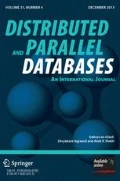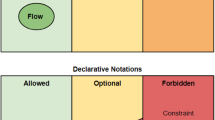Abstract
Differences in features supported by the various contemporary commercial workflow management systems point to different insights of suitability and different levels of expressive power. The challenge, which we undertake in this paper, is to systematically address workflow requirements, from basic to complex. Many of the more complex requirements identified, recur quite frequently in the analysis phases of workflow projects, however their implementation is uncertain in current products. Requirements for workflow languages are indicated through workflow patterns. In this context, patterns address business requirements in an imperative workflow style expression, but are removed from specific workflow languages. The paper describes a number of workflow patterns addressing what we believe identify comprehensive workflow functionality. These patterns provide the basis for an in-depth comparison of a number of commercially availablework flow management systems. As such, this paper can be seen as the academic response to evaluations made by prestigious consulting companies. Typically, these evaluations hardly consider the workflow modeling language and routing capabilities, and focus more on the purely technical and commercial aspects.
Similar content being viewed by others
References
W.M.P. van der Aalst, “Chapter 10: Three good reasons for using a petri-net-based workflow management system,” in Information and Process Integration in Enterprises: Rethinking documents, T. Wakayama et al. (Eds.). The Kluwer International Series in Engineering and Computer Science, Kluwer Academic Publishers: Norwell, 1998, pp. 161–182.
W.M.P. van der Aalst, “The application of petri nets to workflow management,” The Journal of Circuits, Systems and Computers, vol. 8, no. 1, pp. 21–66, 1998.
W.M.P. van der Aalst and P.J.S. Berens, “Beyond workflow management: Product-driven case handling,” in International ACM SIGGROUP Conference on Supporting Group Work (GROUP 2001), S. Ellis, T. Rodden, and I. Zigurs (Eds.), ACM Press: New York, 2001, pp. 42–51.
W.M.P. van der Aalst and K.M. van Hee, Workflow Management: Models, Methods, and Systems, MIT Press: Cambridge, MA, 2002.
W.M.P. van der Aalst, A.H.M. ter Hofstede, B. Kiepuszewski, and A.P. Barros, “Workflow patterns home page,” Available at http://www.tm.tue.nl/it/research/patterns/.
W.M.P. van der Aalst, A.H.M. ter Hofstede, B. Kiepuszewski, and A.P. Barros, “Advanced workflow pat-terns,” in 7th International Conference on Cooperative Information Systems (CoopIS 2000), O. Etzion and P. Scheuermann (Eds.), vol. 1901 of Lecture Notes in Computer Science, Springer-Verlag: Berlin, 2000, pp. 18–29.
W.M.P. van der Aalst, A.H.M. ter Hofstede, B. Kiepuszewski, and A.P. Barros, “Workflow patterns,” BETA Working Paper Series, WP 47, Eindhoven University of Technology, Eindhoven, 2000.
W.M.P. van der Aalst, A.H.M. ter Hofstede, B. Kiepuszewski, and A.P. Barros, “Workflow patterns,” QUT Technical report, FIT-TR-2002–02, Queensland University of Technology, Brisbane, 2002. (Also see http://www.tm.tue.nl/it/research/patterns.).
A. Agostini and G. De Michelis, “Improving flexibility of workflowmanagement systems,” in Business Process Management: Models, Techniques, and Empirical Studies, W.M.P. van der Aalst, J. Desel, and A. Oberweis (Eds.), vol. 1806 of Lecture Notes in Computer Science, Springer-Verlag: Berlin, 2000, pp. 218–234.
P. Athena, Flower User Manual, Pallas Athena BV: Apeldoorn, The Netherlands, 2001.
P. Barthelmess and J. Wainer, “Enhancing workflow systems expressive power,” (Unpublished), 1999.
R. Casonato, “Gartner group research note 00057684, production-class workflow: A view of the market.” 1998. Available at http://www.gartner.com.
F. Casati, S. Ceri, B. Pernici, and G. Pozzi, “Conceptual modeling of workflows,” in Proceedings of the OOER'95, 14th International Object-Oriented and Entity-Relationship Modelling Conference, M.P. Papazoglou (Ed.), vol. 1021 of Lecture Notes in Computer Science, Springer-Verlag, Dec. 1995, pp. 341–354.
F. Casati, S. Ceri, B. Pernici, and G. Pozzi, “Workflow evolution,” Data & Knowledge Engineering, vol. 24, no. 3, 211–238, January 1998.
A. Do¢gac, L. Kalinichenko, M. Tamer Ozsu, and A. Sheth (Eds.), Workflow Management Systems and In-teroperability, vol. 164 of NATO ASI Series F: Computer and Systems Sciences. Springer: Berlin, Germany, 1998.
C.A. Ellis and G.J. Nutt, “Modelling and enactment of workflow systems,” in Application and Theory of Petri Nets 1993, M. Ajmone Marsan (Ed.), vol. 691 of Lecture Notes in Computer Science, Springer-Verlag, Berlin, 1993, pp. 1–16.
FileNet, Visual WorkFlo Design Guide. FileNet Corporation, Costa Mesa, CA, USA, 1997.
FileNet, Panagon Visual WorkFlo Architecture. FileNet Corporation, Costa Mesa, CA, USA, 1999.
Forté, Forté Conductor Process Development Guide, Forté Software, Inc. Oakland, CA, USA, 1998.
M. Fowler, Analysis Patterns: Reusable Object Models, Addison-Wesley: Reading, MA, 1997.
Fujitsu, i-Flow Developers Guide, Fujitsu Software Corporation: San Jose, CA, USA, 1999.
E. Gamma, R. Helm, R. Johnson, and J. Vlissides, Design Patterns: Elements of Reusable Object-Oriented Software. Addison-Wesley: Reading, MA, 1995.
D. Georgakopoulos, M. Hornick, and A. Sheth, “An overview of workflow management: from process modeling to workflow automation infrastructure,” Distributed and Parallel Databases, vol. 3, pp. 119–153, 1995.
A. Hirnschall, “Patterns discusion in the context of co-flow, CONDIS workflow management system (in German),” Technical Report, University of Linz, Austria, 2001.
HP, HP Changengine Process Design Guide, Hewlett-Packard Company: Palo Alto, CA, USA, 2000.
IBM, IBM MQSeries Workflow--Getting Started With Buildtime, IBM Deutschland Entwicklung GmbH: Boeblingen, Germany, 1999.
S. Jablonski and C. Bussler, Workflow Management: Modeling Concepts, Architecture, and Implementation, International Thomson Computer Press, 1996.
B. Kiepuszewski, Expressiveness and Suitability of Languages for Control Flow Modelling in Workflows (submitted). Ph.D. Thesis, Queensland University of Technology, Brisbane, Australia, 2002.
B. Kiepuszewski, A.H.M. ter Hofstede, and C. Bussler, “On structured workflow modelling,” in Proceed-ings of the Twelfth International Conference on Advanced Information Systems Engineering (CAiSE'2000), B. Wangler and L. Bergman (Eds.), vol. 1789 of Lecture Notes in Computer Science, Springer-Verlag: Stockholm, Sweden, June 2000, pp. 431–445.
M. Klein, C. Dellarocas, and A. Bernstein (Eds.), Adaptive Workflow Systems,vol 9 of fSpecial issue of the journal of Computer Supported Cooperative Work, 2000.
T.M. Koulopoulos, The Workflow Imperative, Van Nostrand Reinhold: New York, 1995.
A. Kumar, W.M.P. van der Aalst, and H.M.W. Verbeek, “Dynamic work distribution in workflow management systems: How to balance quality and performance? Journal of Management Information Systems, vol. 18, no. 3, pp. 157–193, 2002.
H. Lavana, A Universally Configurable Architecture for Taskflow-Oriented Design of a Distributed Col-laborative Computing Environment, Ph.D. Thesis, Department of Computer Science, North Carolina State University, Raleigh, NC, USA, 2000.
P. Lawrence (Ed.), Workflow Handbook 1997, Workflow Management Coalition. John Wiley and Sons: New York, 1997.
F. Leymann and D. Roller, Production Workflow: Concepts and Techniques, Prentice-Hall PTR: Upper Saddle River, New Jersey, USA, 1999.
J. Lonchamp, “Process model patterns for collaborative work,” in Proceedings of the 15th IFIP World Computer Congress, Telecooperation Conference, Telecoop'98, Vienna, Austria, July 1998.
G. Meszaros and K. Brown, “A pattern language for workflow systems,” in Proceedings of the 4th Pattern Languages of Programming Conference, Washington University Technical Report 97–34 (WUCS–97–34), 1997.
S.P. Nielsen, C. Easthope, P. Gosselink, K. Gutsze, and J. Roele, Using Lotus Domino Workflow 2.0, Redbook SG24–5963–00. IBM, Poughkeepsie, USA, 2000.
Promatis, Income Workflow User Manual, Promatis GmbH, Karlsbad, Germany, 1998.
W. Reisig and G. Rozenberg (Eds.), Lectures on Petri Nets I: Basic Models, vol. 1491 of Lecture Notes in Computer Science, Springer-Verlag: Berlin, 1998.
D. Riehle and H. Zullighoven, “Understanding and using patterns in software development,” Theory and Practice of Object Systems, vol. 2, no. 1, pp. 3–13, 1996.
SAP, WF SAP Business Workflow, SAP AG, Walldorf: Germany, 1997.
T. Schäl, Workflow Management for Process Organisations, vol. 1096 of Lecture Notes in Computer Science, Springer-Verlag: Berlin, 1996.
A.P. Sheth, W.M.P. van der Aalst, and I.B. Arpinar, “Processes driving the networked economy: ProcessPortals, ProcessVortex, and dynamically trading processes,” IEEE Concurrency, vol. 7, no. 3, pp. 18–31, 1999.
A. Sheth, K. Kochut, and J. Miller, “Large scale distributed information systems (LSDIS) laboratory,” METEOR project page. Available at http://lsdis.cs.uga.edu/proj/meteor/meteor.html.
Software-Ley, COSA 3.0 User Manual, Software-Ley GmbH: Pullheim, Germany, 1999.
Eastman Software, RouteBuilder Tool User's Guide, Eastman Software, Inc.” Billerica, MA, USA, 1998.
Staffware, Staffware 2000 / GWD User Manual, Staffware plc: Berkshire, UK, 2000.
Tibco, TIB/InConcert Process Designer User's Guide, Tibco Software Inc.: Palo Alto, CA, USA, 2000.
Verve, Verve Component Workflow Engine Concepts, Verve, Inc.: San Francisco, CA, USA, 2000.
K. de Vries and O. Ommert, “Advanced workflow patterns in practice (1): Experiences based on pension processing (in Dutch),” Business Process Magazine, vol. 7, no. 6, pp.15–18, 2001.
K. de Vries and O. Ommert, “Advanced workflow patterns in practice (2): Experiences based on judicial processes (in Dutch),” Business Process Magazine, vol. 8, no. 1, pp. 20–23, 2002.
H. Weigand, A. de Moor, and W.J. van den Heuvel, “Supporting the evolution of workflow patterns for virtual communities,” Electronic Markets, vol. 10, no. 4, pp. 264–271, 2000.
WFMC, Workflow Management Coalition Terminology & Glossary, Document Number WFMC-TC-1011, Document Status--Issue 3.0, February. Technical report, Workflow Management Coalition, Brussels, 1999.
Author information
Authors and Affiliations
Rights and permissions
About this article
Cite this article
van der Aalst, W., ter Hofstede, A., Kiepuszewski, B. et al. Workflow Patterns. Distributed and Parallel Databases 14, 5–51 (2003). https://doi.org/10.1023/A:1022883727209
Issue Date:
DOI: https://doi.org/10.1023/A:1022883727209




